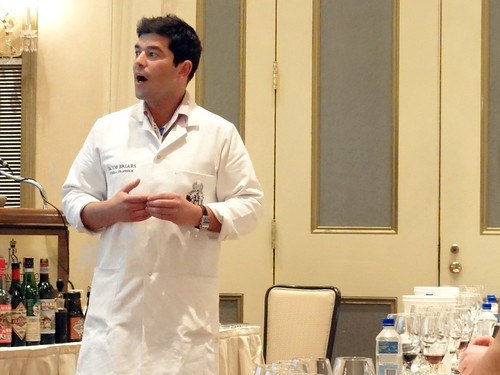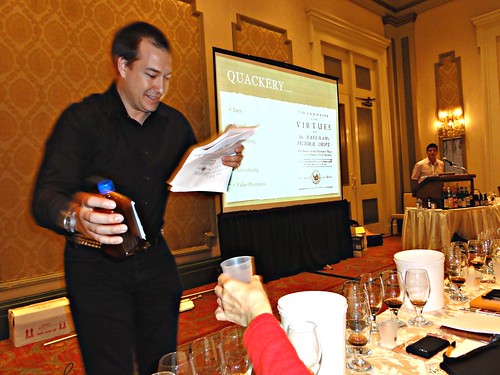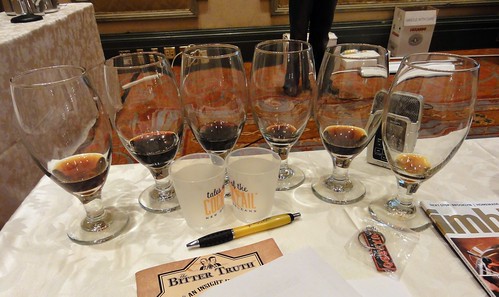My palate has shifted over the last year. I know this, because at Tales of the Cocktail 2009, I had my first taste of Amaro — and I didn’t know what to make of it. Amaro is a category of Italian liqueurs noted for their bitter flavor. The stuff I had, Amaro Averna, threw me for a loop, and I certainly didn’t think it was something I’d ever enjoy.
But a few months ago, I picked up a bottle of Cynar on a whim, and to my surprise I loved it. Since then I’ve tried just about every Amaro I can get my hands on. When I revisited Averna, I was really knocked out by how wonderful it is.
How to account for this? I don’t know. But it seems I’m not the only one who’s feeling the love, judging by the packed room (160 attendees) at Thursday’s seminar, “A Shot of Black Stuff: Amazing Amaros and Brilliant Bitters.”
I signed up for this one based on the topic, but when I realized it was led by Jacob Briars I knew I was in for a special treat. I saw him last year in a presentation that involved splattering the audience with absinthe in the interest of science. But where was his accomplice, Sebastian Reaburn?
Sure enough, Jacob had only just gotten started when Sebastian burst in and made like an old time medical huckster, going round the room and offering everyone a sample of his “Koala Brand” bitters.
He soon revealed that he’d made these bitters from Listerine, NyQuil, gin and Chartreuse. To his credit he warned people not to drink it. The point of this shenanigan, I think, was that many bitters have their roots in some pretty dubious medical quackery.
Then we got down to the serious matter at hand, not just Amari but also bitters. These two topics were lumped together, as the name of the seminar implied. They are distinct but related categories. Bitters are a key ingredient in many classic cocktails but are so powerfully aromatic that they are generally measured in drops; Amari on the other hand can be drunk by the glass (Jacob called them “pouring bitters”) and do not have as much currency in cocktails.
(Which makes me wonder — which topic drew the crowd?)
We discussed the medical traditions from which bitters sprang: Galen’s theory of humors, and the doctrine of signatures. Interestingly enough, there was a lot of American history here, as the manufacture and marketing of bitters as medicine seems to have been quite a phenomenon in the New World. George Washington was mentioned as a victim of the questionable medical practices of the time; Abraham Lincoln came up a couple times too, particularly the fact that some wacky “onguement” tried to take credit for his beard.
We sampled some mushroom bitters which Jacob had made himself from reishi mushroom extract, mushroom puree, vodka and cinnamon. It was truly some of the nastiest stuff I’ve ever tasted. As Jacob said, “Even though I made it myself I must confess it tastes fucking disgusting.” He was quite sincere, however, in praising the health benefits of reishi mushrooms. The point they intended to drive home, I think, was that the bitters which survive today must either taste good — or actually work as medicine.
Sebastian delivered the take-home message succinctly: “Bitters were not in a cocktail to make the cocktail taste good; the cocktail was added to the bitters to make the bitters taste good.”
To make up for the mushroom bitters, we had a cocktail made with an Amaro, an Averna Pineapple Shrub, which was of course delicious. Yet the discussion was still focused on bitters rather than Amari. One of the primary challenges at Tales of the Cocktail is synchronizing a presentation with the drinks being offered. Finally, about halfway through presentation, they shifted gears and started talking about Amari.
We tasted six Amari. Well, actually five. The first glass was Antica Formula, which they claimed to be the first vermouth. It was great and if I ever see it on a local shelf I will snatch it up. The five Amari we sampled were: Averna, Luxardo Abano, Bitter Truth Elixier, Fernet Branca, and Braulio.
What worked for me in this seminar: Jacob and Sebastian. Their irreverent and dynamic style of presentation was entertaining and also educational. What didn’t work so well, in my opinion, was the conflation of two distinct but related topics. I found the transition between the two a little awkward, the connection a bit tenuous. I think we had here a case of two great seminars crammed into one. Despite the fast pace, they just couldn’t cover all this material in the allotted time, and so some things were given short shrift. For example, they promised to explore a connection between bitters and fascism, which sounded fascinating, but that never materialized. I learned a lot more about bitters than I expected, but also a lot less about Amari than I had hoped for.
Our final cocktail was a Bax Beet Pinot as invented at the Tippling Club, which drew a big round of well-deserved applause.
Definitely a step up from the Koala Brand bitters.





Dorginac’s started carrying Carpano Antica a few months back. It’s sold by the liter only. Look for it in a big tin.
And I was just there Sunday buying some vermouth, but I missed it. Curses!
It’s shelved with the liqueurs, not the vermouths.
This link has a photo of the tin:
http://www.cocktailmatch.com/users/452/blog/blue%20carpano.jpg